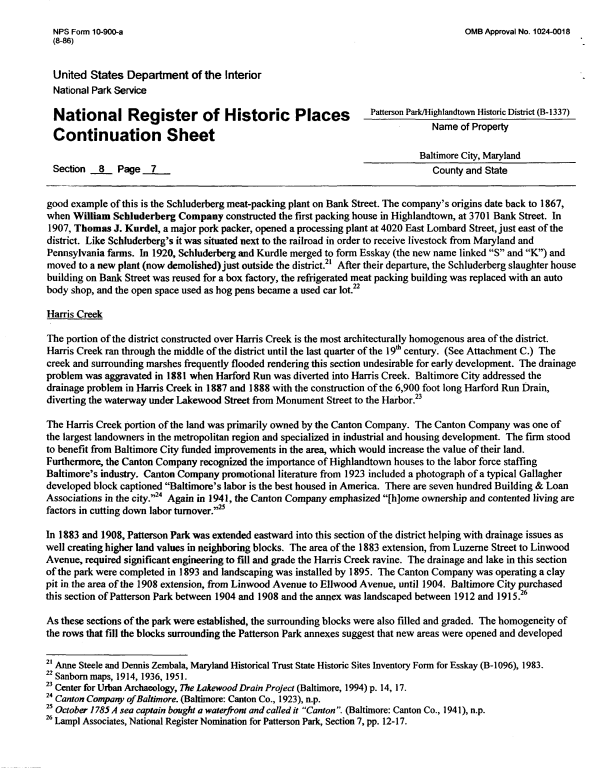 |
||||
|
DEPARTMENT OF HOUSING AND COMMUNITY DEVELOPMENT, MARYLAND HISTORICAL TRUST (Historic Sites Survey) var.d. MSA SE16-3 Image No: se16-3-0102 Enlarge and print image (90K) |
 |
||||
|
DEPARTMENT OF HOUSING AND COMMUNITY DEVELOPMENT, MARYLAND HISTORICAL TRUST (Historic Sites Survey) var.d. MSA SE16-3 Image No: se16-3-0102 Enlarge and print image (90K) |
| NPS Form 10-900-a OMB Approval No. 1024-0018 (8-86) United States Department of the Interior National Park Service National Register of Historic Places Patterson park/Highland^ Historic District (8-133?) ^ <•*•*%•- Name of Property Continuation Sheet Baltimore City, Maryland Section 8 Page 7 County and State good example of this is the Schluderberg meat-packing plant on Bank Street. The company's origins date back to 1867, when William Schluderberg Company constructed the first packing house in Highlandtown, at 3701 Bank Street. In 1907, Thomas J. Kurdel, a major pork packer, opened a processing plant at 4020 East Lombard Street, just east of the district. Like Schluderberg's it was situated next to the railroad in order to receive livestock from Maryland and Pennsylvania farms. In 1920, Schluderberg and Kurdle merged to form Esskay (the new name linked "S" and "K") and moved to a new plant (now demolished) just outside the district.21 After their departure, the Schluderberg slaughter house building on Bank Street was reused for a box factory, the refrigerated meat packing building was replaced with an auto body shop, and the open space used as hog pens became a used car lot.22 Harris Creek The portion of the district constructed over Harris Creek is the most architecturally homogenous area of the district. Harris Creek ran through the middle of the district until the last quarter of the 19th century. (See Attachment C.) The creek and surrounding marshes frequently flooded rendering this section undesirable for early development. The drainage problem was aggravated in 1881 when Harford Run was diverted into Harris Creek. Baltimore City addressed the drainage problem in Harris Creek in 1887 and 1888 with the construction of the 6,900 foot long Harford Run Drain, diverting the waterway under Lakewood Street from Monument Street to the Harbor.23 The Harris Creek portion of the land was primarily owned by the Canton Company. The Canton Company was one of the largest landowners in the metropolitan region and specialized in industrial and housing development. The firm stood to benefit from Baltimore City funded improvements in the area, which would increase the value of their land. Furthermore, the Canton Company recognized the importance of Highlandtown houses to the labor force staffing Baltimore's industry. Canton Company promotional literature from 1923 included a photograph of a typical Gallagher developed block captioned "Baltimore's labor is the best housed in America. There are seven hundred Building & Loan Associations in the city."24 Again in 1941, the Canton Company emphasized "[h]ome ownership and contented living are factors in cutting down labor turnover."25 In 1883 and 1908, Patterson Park was extended eastward into this section of the district helping with drainage issues as well creating higher land values in neighboring blocks. The area of the 1883 extension, from Luzerne Street to Linwood Avenue, required significant engineering to fill and grade the Harris Creek ravine. The drainage and lake in this section of the park were completed in 1893 and landscaping was installed by 1895. The Canton Company was operating a clay pit in the area of the 1908 extension, from Linwood Avenue to Ellwood Avenue, until 1904. Baltimore City purchased this section of Patterson Park between 1904 and 1908 and the annex was landscaped between 1912 and 1915.26 As these sections of the park were established, the surrounding blocks were also filled and graded. The homogeneity of the rows that fill the blocks surrounding the Patterson Park annexes suggest that new areas were opened and developed 21 Anne Steele and Dennis Zembala, Maryland Historical Trust State Historic Sites Inventory Form for Esskay (B-1096), 1983. 22 Sanbornmaps, 1914, 1936, 1951. 23 Center for Uiban Archaeology, The Lakewood Drain Project (Baltimore, 1994) p. 14, 17. 24 Canton Company of Baltimore. (Baltimore: Canton Co., 1923), n.p. 25 October 1785 A sea captain bought a -waterfront and catted it "Canton ". (Baltimore: Canton Co., 1941), n.p. 26 Lamp! Associates, National Register Nomination for Patterson Park, Section 7, pp. 12-17. |